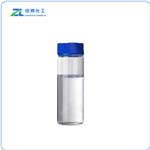Platinum(0)-1,3-divinyl-1,1,3,3-tetramethyldisiloxane: applications and safety
Nov 13,2023
General Description
Platinum(0)-1,3-divinyl-1,1,3,3-tetramethyldisiloxane is a catalyst with remarkable hydrosilylation activity. This compound is widely used in the synthesis of organosilicon compounds, finding applications in industries such as pharmaceuticals, materials science, and electronics. Its catalytic activity is attributed to the platinum metal center, which activates and stabilizes reactive intermediates during the reaction. The presence of divinyl and tetramethyldisiloxane ligands further enhances its performance. The catalyst enables efficient conversion of carbon-carbon double or triple bonds to silicon-carbon bonds under mild conditions, with high selectivity and minimal side reactions. Additionally, Platinum(0)-1,3-divinyl-1,1,3,3-tetramethyldisiloxane is utilized in the synthesis of phosphorescent polyhedral oligomeric silsesquioxane (POSS) materials, resulting in the formation of materials with desirable properties such as thermal stability, solubility, and high purity. However, it is important to note that this compound is highly flammable and poses safety risks.

Figure 1. Platinum(0)-1,3-divinyl-1,1,3,3-tetramethyldisiloxane
Applications
Hydrosilylation activity
Platinum(0)-1,3-divinyl-1,1,3,3-tetramethyldisiloxane is a catalyst with remarkable hydrosilylation activity. Hydrosilylation is a chemical reaction that involves the addition of a silicon-hydrogen bond (Si-H) across a carbon-carbon double or triple bond. This process is widely used in the synthesis of various organosilicon compounds, which find applications in industries such as pharmaceuticals, materials science, and electronics. The catalytic activity of Platinum(0)-1,3-divinyl-1,1,3,3-tetramethyldisiloxane is primarily attributed to the platinum metal center. Platinum is known for its excellent catalytic properties due to its ability to activate and stabilize reactive intermediates during the reaction. The presence of divinyl and tetramethyldisiloxane ligands further enhances the catalytic performance by providing steric and electronic effects, respectively. The hydrosilylation activity of this catalyst enables efficient conversion of carbon-carbon double or triple bonds to silicon-carbon bonds, resulting in the formation of valuable organosilicon compounds. The reaction proceeds under mild conditions, making it suitable for a wide range of substrates. Additionally, Platinum(0)-1,3-divinyl-1,1,3,3-tetramethyldisiloxane exhibits high selectivity, yielding desired products with minimal side reactions. In conclusion, Platinum(0)-1,3-divinyl-1,1,3,3-tetramethyldisiloxane is a highly effective catalyst for hydrosilylation reactions. Its unique molecular structure and platinum metal center contribute to its exceptional catalytic activity, making it a valuable tool in organic synthesis and industrial applications. 1
Synthesis of POSS materials
Platinum(0)-1,3-divinyl-1,1,3,3-tetramethyldisiloxane finds significant application as a catalyst in the synthesis of phosphorescent polyhedral oligomeric silsesquioxane (POSS) materials. By employing hydrosilylation reaction with Pt-dvs as the catalyst, three novel phosphorescent POSS materials were successfully synthesized. These materials consisted of the emissive Ir(iii) complex and carbazole moieties covalently attached to a polyhedral oligomeric silsesquioxane (POSS) core. The resulting POSS materials exhibited desirable properties such as amorphous nature, excellent thermal stability, good solubility in common solvents, and high purity through column chromatography. The photoluminescence spectra of the POSS materials, both in solution and the solid state, demonstrated reduced interactions among the Ir(iii) complex units and minimized concentration quenching, thanks to the bulky POSS core. Moreover, solution processed light-emitting devices based on these phosphorescent POSS materials showcased a maximum external quantum efficiency (EQE) of 9.77%. In summary, Platinum(0)-1,3-divinyl-1,1,3,3-tetramethyldisiloxane serves as a crucial catalyst in the synthesis of phosphorescent POSS materials, enabling the formation of efficient light-emitting devices with desirable properties such as high EQE, good solubility, and thermal stability. This research highlights the potential applications of Platinum(0)-1,3-divinyl-1,1,3,3-tetramethyldisiloxane in the development of advanced optoelectronic materials. 2
Safety
Platinum(0)-1,3-divinyl-1,1,3,3-tetramethyldisiloxane is a highly flammable and hazardous compound that poses various safety risks. It can easily catch fire and should be stored away from heat and open flames. Direct contact with the substance can cause skin and eye irritation, requiring the use of protective gloves and goggles. Inhalation of its vapors may irritate the respiratory system, necessitating adequate ventilation. There are concerns about its potential adverse effects on fertility, unborn children, and aquatic life. Pregnant individuals should avoid exposure, and proper disposal methods should be employed to prevent environmental contamination. To ensure safety, careful handling and storage of this compound are essential. 3
Reference
1. Iimura T, Akasaka N, Kosai T, Iwamoto T. A Pt(0) complex with cyclic (alkyl)(amino)silylene and 1,3-divinyl-1,1,3,3-tetramethyldisiloxane ligands: synthesis, molecular structure, and catalytic hydrosilylation activity. Dalton Trans. 2017 Jul 11;46(27):8868-8874.
2. Yu T, Xu Z, Su W, Zhao Y, Zhang H, Bao Y. Highly efficient phosphorescent materials based on Ir(iii) complexes-grafted on a polyhedral oligomeric silsesquioxane core. Dalton Trans. 2016 Sep 14;45(34):13491-13502.
3. PubChem. COMPOUND SUMMARY: Platinum(0)-1,3-divinyl-1,1,3,3-tetramethyldisiloxane. National Library of Medicine. PubChem CID: 10959889.
- Related articles
- Related Qustion
- The Role and Synthesis of Platinum(0)-1,3-Divinyl-1,1,3,3-Tetramethyldisiloxane Complexes in Catalysis Mar 6, 2024
Platinum (0) -1,3-diethylene-1,1,3,3-tetramethyldisiloxane, with its excellent stability, reactivity, and selectivity, heralds a new era of catalysis.
- Applications of Karstedt Catalysts Dec 21, 2021
Karstedt catalysts promote a quick, low temperature curing of the hydrosilylation reaction. They form silicone elastomers through an addition curing cross-linking reaction between Si-vinyl and Si-H groups.
Lithium aluminum deuteride is a versatile compound with important applications but requires careful handling due to its hazardous nature.....
Nov 13,2023APIDespite its cytotoxic effects, Triethylene glycol dimethacrylate is vital for creating antibacterial dental composites with desirable properties.....
Nov 13,2023APIYou may like
Platinum(0)-1,3-divinyl-1,1,3,3-tetramethyldisiloxane manufacturers
- Platinum(0)-1,3-divinyl-1,1,3,3-tetramethyldisiloxane
-

- $0.00 / 1kg
- 2025-04-07
- CAS:68478-92-2
- Min. Order: 1kg
- Purity: 98
- Supply Ability: 1000
- Platinum(0)-1,3-divinyl-1,1,3,3-tetramethyldisiloxane
-

- $10.00 / 1kg
- 2025-04-02
- CAS:68478-92-2
- Min. Order: 1kg
- Purity: 99%
- Supply Ability: 20ton
- Platinum(0)-1,3-divinyl-1,1,3,3-tetramethyldisiloxane Platinum
-

- $1.00 / 1KG
- 2025-03-31
- CAS:68478-92-2
- Min. Order: 1KG
- Purity: 99%
- Supply Ability: 10mt






